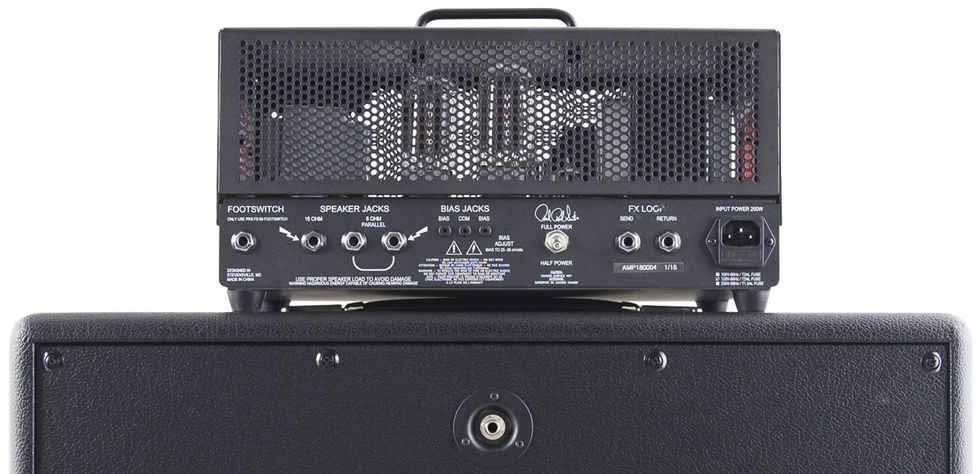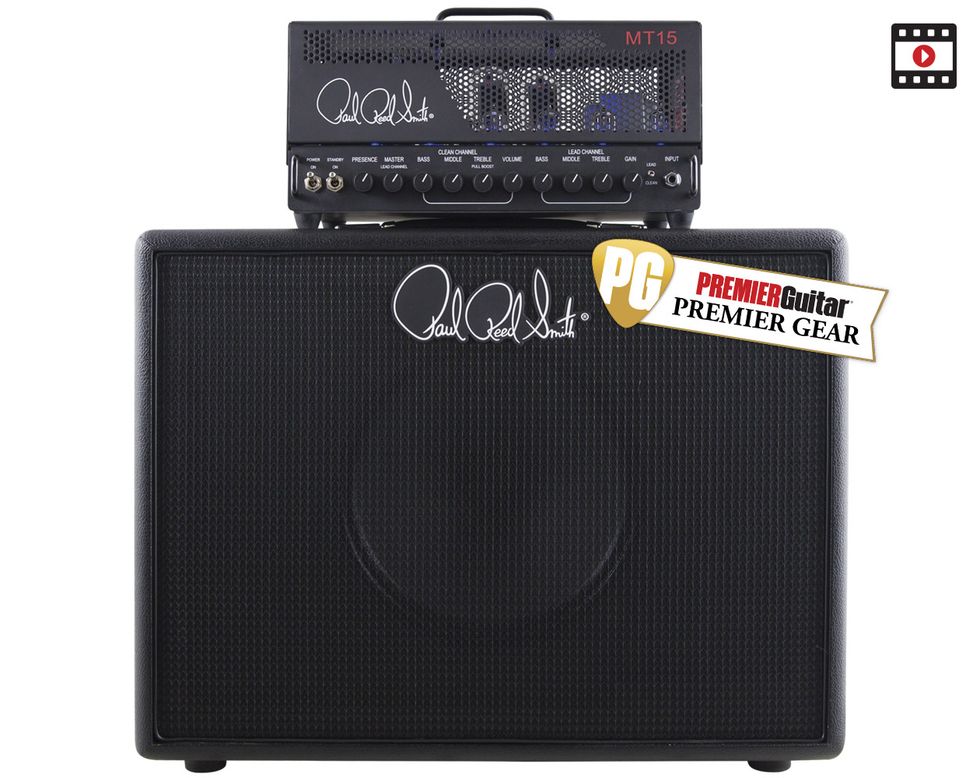RatingsPros:Delectable high-gain lead tones coupled to an impressively tight, weighty low end, all at a very impressive price. Cons: Many players would likely enjoy a master volume on the clean channel, to enable a little bite from that mode. Street: $649; speaker cab $389 street PRS Mark Tremonti Signature MT15 prsguitars.com | Tones: Ease of Use: Build/Design: Value: |
Mark Tremonti has used and endorsed PRS’s USA-made Core and Asia-built SE guitars for years. Now he’s exploring the other half of his sound with PRS via the new MT15 Mark Tremonti Signature Amplifier and 1x12 speaker cabinet.
In the form of the MT15, Tremonti’s incendiary high-gain tones live in a compact, low-wattage lunchbox head suited to home-jams, studio, and small-club use. It’s a much more practical option than a version of the mammoth 100-watt rigs Tremonti habitually tours with. It also sells at an impressively affordable price.
Big Bottles, Robust Bones
While the MT15 might be small, Tremonti and PRS have clearly designed the amp with the intent of punching above its weight (which is an almost feather-light 17.8 pounds) class. The MT15 uses a pair of big 6L6GC output tubes rather than the 6V6s or EL84s that would typically propel a 15-watter. Six 12AX7s drive the front end, which includes a foot-switchable, 2-channel preamp offering gain, treble, middle, bass, and master volume controls on the lead channel, and volume, treble (pull boost), middle, and bass controls on the clean channel. The two channels share a presence control.
Why the big bottles, when smaller options can generate the same power? PRS chief amp designer Doug Sewell tells us, “When developing the amp with Mark, we tried 6V6s first. However, his favorite tube is the 6V6’s big brother, the 6L6, and we realized that we couldn’t get a tone he was happy with without using those.
We were given the mandate to achieve certain characteristics of his touring rig amps—a tough nut to crack with 15 watts! We decided to adapt 6L6s to a lower-powered circuit design by reducing the plate voltage, with smaller power and output transformers. We added some metal-amp-design techniques to give the low-end legitimacy without flabbiness, and the 6L6s give that full and rounded tone down there to begin with.”
Rear-panel features include a half-power switch to take the output down to 7 watts, send and return jacks for the FX loop, dual parallel 8-ohm outputs, a single 16-ohm out, a jack for the one-button channel footswitch, and handy bias check and adjustment points so you can re-tube the fixed-bias head without opening up the chassis. Components are arranged along a large printed circuit board, to which the potentiometers and preamp tube-sockets are also mounted. The bigger octal output-tube sockets are mounted to the chassis—a wise move to divert damaging heat from the circuit board itself.
The accompanying MT15 speaker cab is a closed-back design made from birch plywood, measuring 24" x 18" x 10.5" and dressed in stealthy black-on-black livery. It houses a single Celestion Vintage 30 speaker, rated at 16 ohms and a 60-watt power-handling capability, and weighs in at 40 pounds.
Pummel Course
Flip the power switch and a row of red or blue LEDs comes alive. (The LEDs also serve as a novel and dramatic means of telling you whether you’re in lead or clean mode). Tested with a Gibson Les Paul with PAFs and a Novo Serus J with P-90s, the MT15 sounded fierce, juicy, and compelling. It’s one of the most convincing voiced-to-sound-big small tube amps that I’ve played in a long while. And frankly, I can’t recall the last time I had this much fun with an amp this small. But that’s the thing: the MT15 doesn’t sound or feel like a small amp.

The lead channel has a lot of gain—you’ll get squeal from microphonic pickups if you don’t stand back—but this channel is all about the scorching, chewy, tactile, harmonically-saturated yet impressively articulate lead tones that it delivers in abundance. As hot as it is, you can still dial down the gain for cranked-plexi-style tones and old-school crunch that betters many more expensive amps aimed squarely at that tone target.
The low frequencies are impressively devoid of the flabbiness that Sewell sought to banish, and while you can’t reasonably expect nausea-inducing low-string gut-punch from a 15-watter—especially through a 1x12 cab—the bass is tight and authoritative and can handle drop-D riffs with bravado. Kudos are in order to the tight and gutsy MT15 speaker cab for its part in delivering this much bottom-end punch.
The clean channel is crisp and bold, with lots of headroom, even with the pull-boost engaged. If anything, I’d like to see a dedicated master volume for the clean channel. The Les Paul wouldn’t even push it into mild breakup until the volume was too loud for many playing situations—even at half-power—and I’m sure loads of players would dig a little pre-crunch bite from this channel. That said, the clean channel makes a great pedal platform, and, all things considered, a lot of headroom is a minor problem given all that the MT15 does so well.
The Verdict
Cleverly conceived, well designed, and ruggedly built at an appealing price, the MT15 delivers easy access to Tremonti-style rock, shred and metal tones. What’s more, the small format makes it well suited to the majority of playing situations that most hobby, aspiring, and semi-pro guitarists face these days. Sure, it’s a 15-watt amp and it will have its limitations, but it delivered more than enough volume and punching power to play un-miked with a loud drummer in rehearsal (and the same would apply to a small club stage) without tapping out the MT15’s capabilities or running out of headroom.
Between the addictively scorching lead tones and impressively girthy low end, it’s a ton of fun play, and a must-try for any rocker seeking a fierce, compact tube rig in the $1K range.
Watch the Review Demo:













![Rig Rundown: Russian Circles’ Mike Sullivan [2025]](https://www.premierguitar.com/media-library/youtube.jpg?id=62303631&width=1245&height=700&quality=70&coordinates=0%2C0%2C0%2C0)







